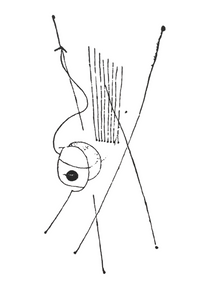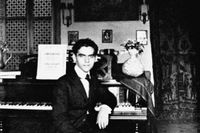"The Duende is a power, not a work. It is a struggle, not a thought... in sum, the spirit of the earth.”
Describing duende as "art done with feeling" is like describing a crow as a "thing that flies & steals." An injustice to both. Duende is a word larger and more powerful than the human who speaks it, and yet we must turn to a human to describe it.
The Duende, then, is a power, not a work. It is a struggle, not a thought. I have heard an old maestro of the guitar say, "The duende is not in the throat; the duende climbs up inside you, from the soles of the feet," Meaning this: it is not a question of ability but of true, living style, of blood, of the most ancient culture, of spontaneous creation. This "mysterious power which everyone senses and no philosopher explains" is, in sum, the spirit of the earth.
Federico García Lorca (June 5, 1898 - August 19, 1936) was a Spanish poet who brought modern European concepts into Spanish literature. His poetry reflected the duel and dance of joy and sorrow in life and the best of art. In 1919, García Lorca left his native Grenada and a job as a lawyer to become a full-time poet in Madrid. He published his first collection, Impresiones y Paisajes, and a few years later wrote Play and Theory of the Duende to achieve "a simple lesson in the hidden, aching spirit of Spain."
The muse dictates and sometimes prompts. She can do relatively little, for she is distant and so tired (I saw her twice) that one would have to give her half a heart of marble. Poets who have muses hear voices and do not know where they are coming from. They come from the muse that encourages them and sometimes snacks on them, as happened to Apollinaire, a great poet destroyed by the horrible muse who appears with him in a certain painting by the divine, angelic Rousseau. The muse awakens the intelligence, bringing a landscape of columns and a false taste of laurel. But intelligence is often the enemy of poetry, because it limits too much, and it elevates the poet to a sharp-edged throne where he forgets that ants could eat him or that a great arsenic lobster could fall suddenly on his things against which the muses that live in monocles and in the lukewarm, lacquered roses of tiny salons are quite helpless.
García Lorca did not invent the word duende, but his "Play and Theory..." is a modern masterpiece that tries to pin down this beautiful, ethereal thing. Neither muse nor inspiration, neither angel of art nor labor of love, the duende is impossible to explain but familiar once witnessed.
Once witnessed, we are all in its grip.
 "La Guitarra" by Federico Garcia Lorca.
"La Guitarra" by Federico Garcia Lorca."Give me a song I can feel, and it's never work," the untrained but supremely gifted singer Billie Holiday wrote in her memoirs. Holiday used the song to express - perhaps expel -unbearable pain and emotion. The power of feeling and the music ignited something in Holiday and her audiences. "I've been told that nobody sings the word 'hunger' like I do. Or the word 'love.' Maybe I remember what those words are all about." Holiday was a singer of undeniable duende.
"All arts are capable of duende," García Lorca instructs, "but where it finds the greatest range is in music, dance, spoken poetry." Garcia Lorca's poetry abounded with reverence for the musical spirit of duende.
Riddle of the Guitar
At the round
crossroads,
six maidens
are dancing.
Three of flesh,
three of silver.
Yesterday's dreams pursue them,
but they are held fast
by a golden Polyphemus.
The guitar!
Adivinanza de la guitarra
En la redonda
encrucijada,
seis doncellas
bailan.
Tres de carne
y tres de plata.
Los sueños de ayer las buscan
pero las tiene abrazadas
un Polifemo de oro.
¡La guitarra!
Of course, he is also quick to remind us that duende comes not from emotion or spirit but rather it it's an inexplicable substance that leads to such things. Its arrival changes the nature of the art and initiates "something newly created, like a miracle, and it produces an almost religious enthusiasm."
The great artists of the south of Spain, whether Gypsy or flamenco, whether they sing, dance, or play, know that no emotion is possible unless the duende comes. They may be able to fool people into thinking they have duende-authors and painters and literary fashionmongers do so every day—but we have only to pay a little attention and not surrender to indifference in order to discover the fraud and chase away their clumsy artifice.
There are many tragedies in García Lorca's life: his unrequited love for Salvador Dalí, his early death, and his unknown burial. Still, the most excruciating aspect of his life is that what he most celebrated, sought, and championed - this inexpressible passion for emotion in art - ultimately led to his death.
 García Lorca in 1919, Spain.
García Lorca in 1919, Spain.Spain's civil war was an unbearably bloody and destructive period. Fascism was one of the factions vying for power in a broken government, and a Nationalist coalition ultimately took control through military rule. García Lorca's poetic profession and life as a homosexual was deemed unacceptable by the repressive regime. In August 1936, García Lorca was arrested in Granada and executed by firing squad two days later. It remains unclear who killed him and where he is buried.
I remain astonished and appreciative that humans created language and continue to test its elasticity to suit our need to articulate and illuminate the most complicated aspects of human life. García Lorca's Play and Theory of the Duende remains one of the best explorations of emotion and art. I'm so glad it exists, I hope it endures.

